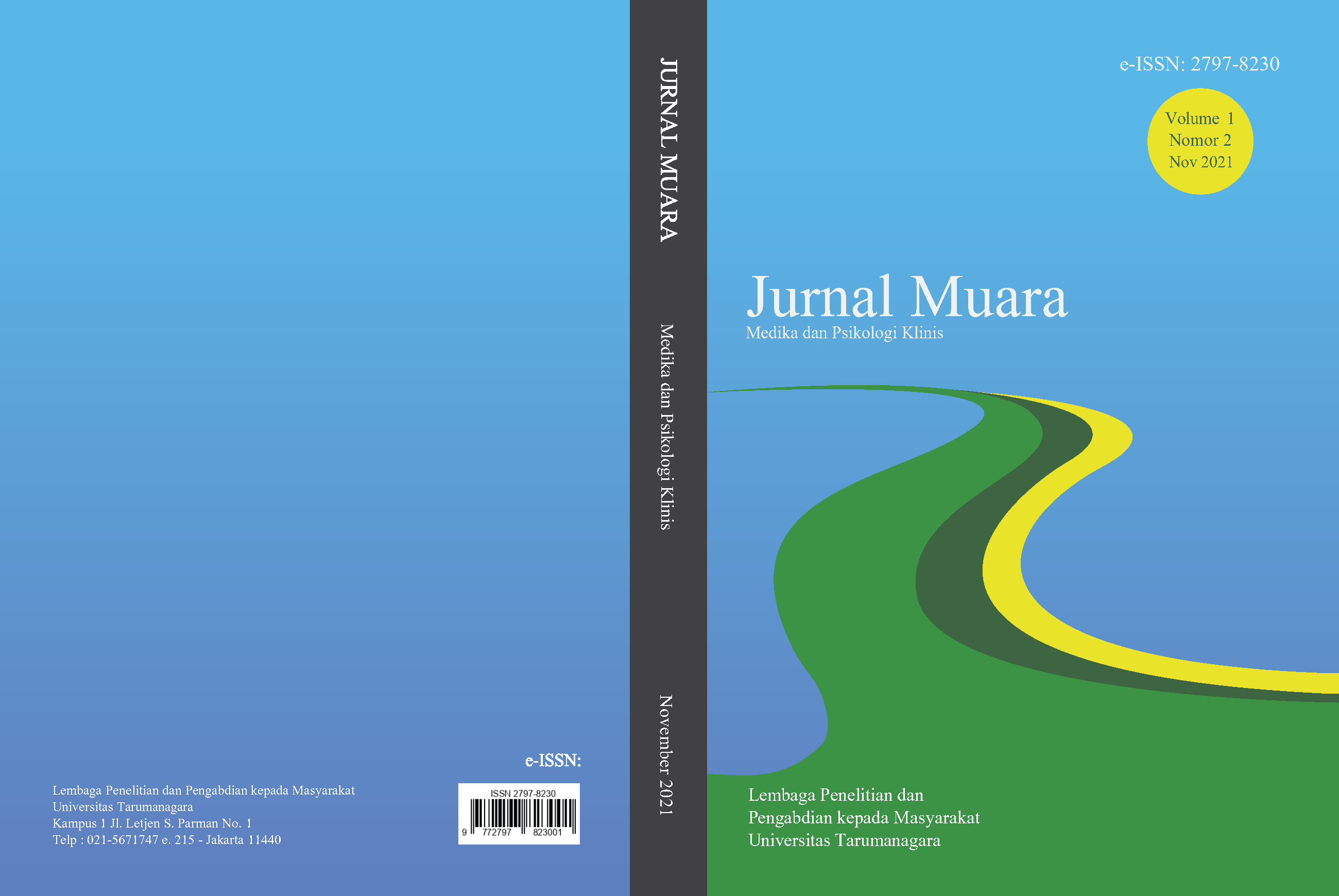UJI TOKSISITAS, AKTIVITAS ANTIOKSIDAN DAN KADAR METABOLIT SEKUNDER DAUN KEMANGI (Ocimum X africanum lour)
Main Article Content
Abstract
High pollutant level has caused an increase in disease that is correlated to Reactive Oxygen Species through a condition that is oxidative stress. Oxidative stress can be stabilized with antioxidants by stabilizing active and unstable radicals to become inactive and stable. Basil leaves (Ocimum x africanum lour) are known to posses antioxidant composition. The aim of this study is to determine the antioxidant ability and toxicity level of basil leaves. The research was conducted through an in vitro experimental study design and bioassays. Extraction of this research was carried out by maceration method using methanol as solvent. The tests were carried out in the form of antioxidant capacity tests using the 1,1-diphenyl-2-picrylhydrazyl method, toxicity tests using the brine shrimph lethality test method on Basil Leaf extract. In basil leaf extract, the antioxidant capacity test obtained IC50 of 174.04 ?g/mL, phenolic level test was 10872,92 mg/mL, alkaloid level test was 8.15 ?g/mL, toxicity test obtained LC50 of 158.36 ?g/mL. This study concludes that basil leaves contain antioxidants not as much as vitamin C however basil leaves do not have an effect that triggers an increase in stomach acid, so it has potential as an alternative antioxidant for a patient with stomach acid disorder, in addition, basil leaves also have cytotoxicity activity that is possible to be used as anti-carsinogen.
Article Details
Section
Notice: Deprecated: The template at plugins/themes/bootstrap3/templates/plugins/generic/citationStyleLanguage/citationblock.tpl has moved and will not be found in the future. in /var/www/html/lib/pkp/classes/plugins/Plugin.php on line 468
How to Cite
References
Aburigal, YAA. Mirghani, MES. Elmogtaba, EY. Sirible, AAM. Hamza, NB. & & Hussein, IH. (2017). Total phenolic content and antioxidant capacity of basil (Ocimum basilicum L.) leaves from different locations. International Food Research Journal twenty-four.,1(1), 378-81.
Avetisyan, A. Markosian, A. Petrosyan, M. et al. (2017). Chemical composition and some biological activities of the essential oils from basil Ocimum different cultivars. BMC Complement Altern Med., 17(1), 60-62.
Blois, MS. (1958). Antioxidant Determinations by the Use of a Stable Free Radical. Nature., 181(1), 1199-1200.
Bunwijit, J. Sripanidkulchai, B. Pannangrong, W. Junlatat, J. & Sripanidkulchai, K. Gastroprotective effect of hydroalcoholic extract of Ocimum x africamum lour leaves. (2017). Songklanakarin Journal of Science & Technology., 39(4), 93-105.
Fatimatuzzahra, F. (2013). Uji toksisitas akut extraks etanol daun kemangi (Ocimum canum Sims) Terhadap larva Artemia salina Leach dengan metode Brine Shrimp Lethality test (BSLT). universitas islam Indonesia., 1(1), 1-36.
Herani, A. Chaerunnisa, Y A. & Subarnas, A. (2019). Antioxidant Activities of Muntingia calabura, Syzygium cumini, Ocimum basilicum, and Eleutherine bulbosa using DPPH Method. Indonesian Journal Of Pharmaceutics., 1(1), 57-61.
Hussain, S. Aneggi, E. & Goi, D. (2021) Catalytic activity of metals in heterogenous Fenton like oxidation of wastewater contaminants: a review. Environmental chemistry Letters., 19(1), 2405-24.
Isa, A. Ositadinma, T. & Benjamin, B. (2018). Evaluation of phytochemical constituents, in vitro antioxidant activity and antimicrobial activity of the leaf extracts of Ocimum basilicum (L). Nigerian Defence academy., 1(1), 813-21.
Lakey, PS. Berkemeier, T. Tong, H. Arangio, AM. Lucas, K. Pöschl, U. & Shiraiwa, M. (2016). Chemical exposure-response relationship between air pollutants and reactive oxygen species in the human respiratory tract. Sci Rep., 6(1), 1-4.
Lobo, V. Patil, A. Phatak, A. & Chandra, N. (2010). Free radicals, antioxidants and functional foods: Impact on human health. Pharmacogn Rev.,4(8), 118-26.
Lodovici, M & Bigagli, E. (2011). Oxidative stress and air pollution exposure. Journal of toxicology., 120(1), 1-6.
Meyer, BN. Ferrigni, NR. Putnam, JE. Jacobsen, LB. Nichols, DE. & McLaughlin, JL. (1982). Brine Shrimp: a convenient general bioassay for active plant constituents. Planta Medica., 45(1), 31-4.
Møller, P., & Loft, S. (2010). Oxidative damage to DNA and lipids as biomarkers of exposure to air pollution. Environmental health perspectives, 118(8), 1126–1136.
Pandey, KB. & Rizvi, SI. (2009). Plant polyphenols as dietary antioxidants in human health and disease. Oxid Med Cell Longev., 1(1), 1-5.
Rajendra, CP. Ved, RS. Gunjan, Bhatt. Amit, CRK. Upadhyay, Ram S. & Verma. (2018). Optimization of harvesting and postharvest drying methods of Ocimum x africanum Lour for production of quality essential oil. Journal of Essential Oil Research., 30(6), 437-443.
Robert, AM. (1982). Encyclopedia of Physical Science and Technology Alkaloids 3rd edition. Academic Press, San Diego.
Sunitha, K. & Rani, CN. (2017). Evaluation of antioxidant properties of ocimum americanum l. seeds. J. Pharm Sci. Innov. 6(6), 128-130.
Yang, W. Omaye, ST. (2009). Air pollutants, oxidative stress and human health. Mutat Res., 1(1), 45-54.

